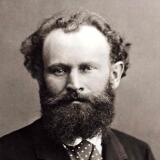Works by Édouard Manet at Sotheby's
Édouard Manet Biography
A leading artist in the transition from realism to Impressionism, Édouard Manet (1832–1883) was an early Modern painter who claimed city life as a worthy subject for high art. He used a direct, alla prima technique – successive layers of paint on a light ground – to create remarkably vibrant canvases whose opaque flatness and sketch-like passages changed the acceptable norms of painting.
Born into an upper-class Parisian family, Manet began studying art formally at 18 while spending hours at the Louvre copying the work of Old Masters. Opening a studio in 1856, he produced such masterful early works as The Absinthe Drinker (1858–59); The Luncheon on The Grass (1863), whose nude female shocked critics though its composition was inspired by Old Master precedents; and Olympia (1863), another Old Master-like creation featuring a highly confrontational prostitute. Painting in a quick, loose style, Manet produced many café scenes that captured the population – bohemian, working-class, bourgeois – and the mood of nightlife in 19th-century Paris, as in Le Café Concert (1878). He offered snapshot of the activities of the wealthy in works such as The Races at Longchamp (1864), as well many fresh ways of seeing and understanding Paris: The Railway (1873), for instance, focuses squarely on the figures located hard against the iron fence, and the only sign of a train is a cloud of smoke. With his health deteriorating in his mid-40s, Manet concentrated on painting small still-lifes of fruit and vegetables, producing his last major work, A Bar at the Folies Bergères, in 1882.
Read Less


















